
The Toshiba EMI Recordings / Original Stereo Version
18. Abbey Road (AP-8815)
(Update: 12th. December 2019)

| TITLE | ABBEY ROAD |
||||
| CATALOG NUMBER | AP-8815 |
||||
| RELEASE DATE | Promotional
Record
(First Press: 21th. October.1969) |
||||
| TRACK LISTING | SIDE 1 | SIDE 2 | |||
| Come Together |
Here Comes The Sun |
||||
| Something |
Because |
||||
| Maxwell's Silver Hammer |
You Never Give Me Your Money |
||||
| Oh! Daring |
Sun King |
||||
| Octopus's Garden |
Mean Mr. Mustard |
||||
| I Want You (She's So Heavy) | Polythene Pam |
||||
| She Came In
Through The Bathroom Window |
|||||
| Golden Slumbers |
|||||
| Carry That Weight |
|||||
| The End | |||||
| (Her Majesty) |
|||||
| FRONT --> Click! | BACK --> Click! | SIDE 1 --> Click! | SIDE 2 --> Click! | DISK | |
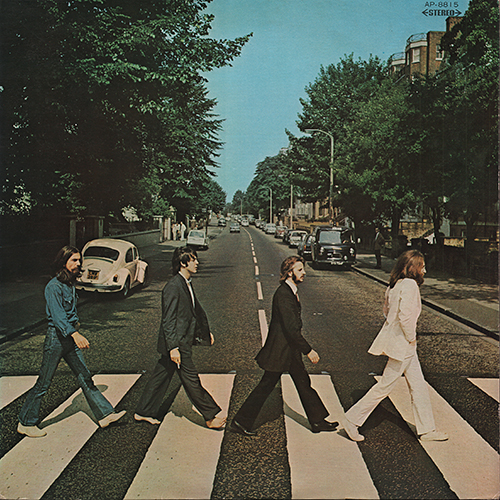 |
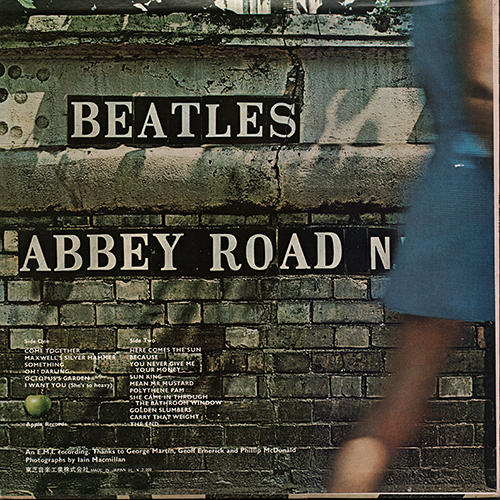 |
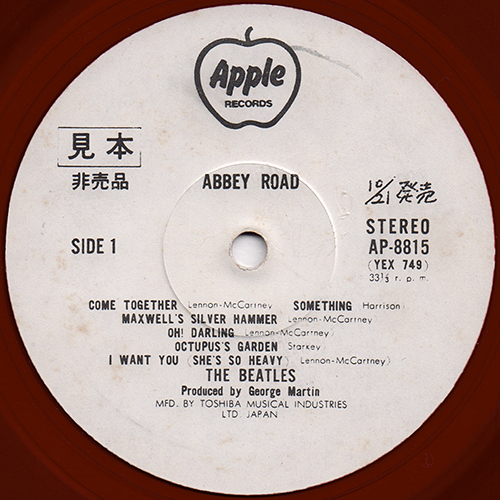 |
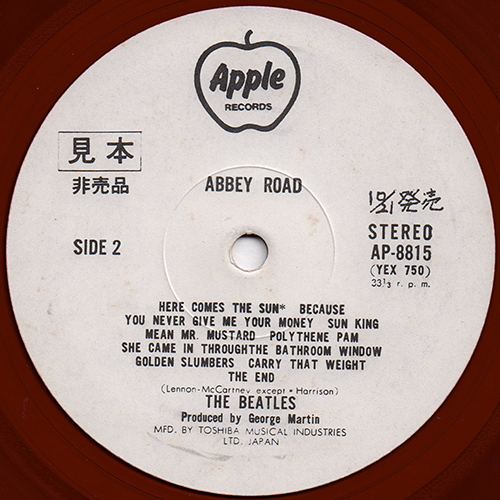 |
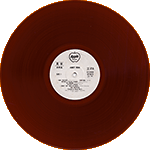 |
|
| INNER SLEEVE |
LYRIC SHEET (Type-1) |
||||
| FRONT --> Click! | BACK --> Click! | FRONT --> Click! | BACK --> Click! | With
Apple
custom black inner sleeve. The lyric sheet is slip sheet type. |
|
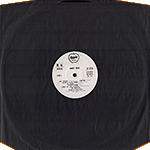 |
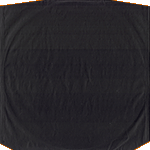 |
 |
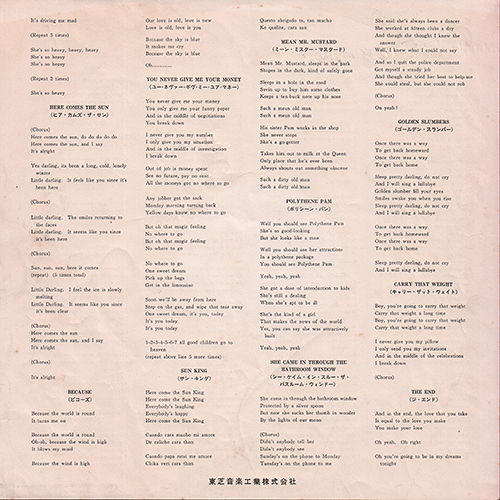 |
||
| LYRIC SHEET
TYPE-1 CLOSE UP |
|||||
 |
 |
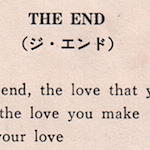 |
Without "Her Majesty" lyric. | ||
| Catalog
number
and
the company name "Toshiba Musical Industries Ltd." were
printed on the lyric sheet. |
|||||
| FRONT COVER CLOSE UP | BACK COVER CLOSE UP | ||||
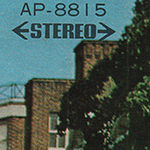 |
Catalogue number "AP-8815"
and "the word "STEREO" were printed at the upper right
corner of the front cover. |
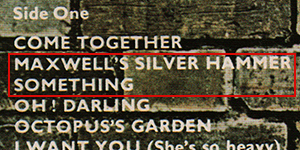 |
The song order on the back
cover is incorrect. "Maxwell's...." and "Something" should be interchanged. |
||
| BACK COVER CLOSE UP | |||||
 |
"Toshiba
Musical Industries Ltd." and "H ¥2,000" was printed at
the bottom of the back cover. |
||||
| LABEL CLOSE UP | |||||
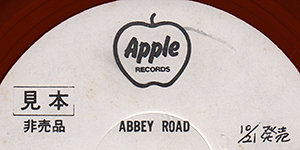 |
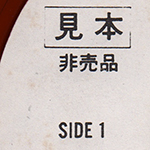 |
Apple white
label (promotional use only). The words "Sample" inside a rectangle and "Not For Sale" were printed at upper left side of the label. The release date was not printed on both labels. |
|||
| LABEL CLOSE UP | |||||
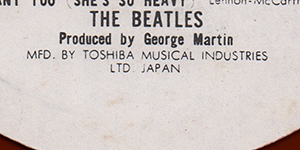 |
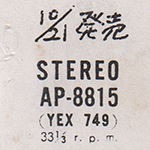 |
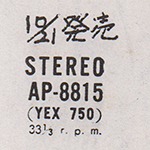 |
Catalogue number and matrix number were printed at the right side of the center hole. | ||
| LABEL CLOSE UP | |||||
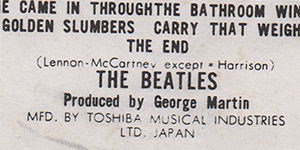 |
The label does not have "Her Majesty" credit on the
side 2. "Produced by George Martin" credit was printed at the below of the group's name. The words "MFD. BY TOSHIBA MUSICAL INDUSTRIES LTD. JAPAN" was printed at the bottom of the label. |
||||
|
OTHER ITEM
|
|||||
| - | |||||
| RECORD LABEL | Apple White Label (for promotional use
only) |
||||
| MIX | STEREO |
||||
| MATRIX No. | SIDE 1 | YEX-749 1S 1 |
|||
| SIDE 2 | YEX-750
1S 1 |
||||
| PRESS MARK | 9B |
||||
| VINYL COLOR | RED |
||||
| RECORD COMPANY'S NAME | SLEEVE | Toshiba
Ongaku kogyo Kabusikigaisha |
|||
| LABEL | MFD. BY
TOSHIBA MUSICAL INDUSTRIES LTD. JAPAN |
||||
| SYMBOL/PRICE | H ¥2,000 |
||||
| LYRIC SHEET STYLE | Slip Sheet Type-1: Without "Her Majesty" lyric version | ||||
| COVER FORM | Single type. Hard cover. |
||||
| INNER SLEEVE |
Apple custom black sleeve |
||||
| OBI |
- |
||||
| COVER DESIGN/ PHOTO/ NOTES | Photo: Iain Macmillan |
||||
|
COMMENTS
|
Apple white label
(promotional use only). The design of Apple white labels deffers markedly from commercial Apple LPs. Promo versions eliminate perimeter print and feature a line drawing of the Apple logo at the label top. All print is black. Notice the promo characters inside a rectangle to the left of the Apple logo. The words "MFD. BY TOSHIBA MUSICAL INDUSTRIES LTD. JAPAN" was printed at the below of the group's name. Promo copies were sometimes sent in generic EMI Sample Record covers. In Japan, promotional records have traditionally been provided at no charge to radio stations, record shops, and the mass media to increase the sales of a record or in some cases to promote a tour. There are two types of promotional releases. Type-1: This type is called the white label promo for which a unique label has been made. The design of Apple white labels deffers markedly from commercial Apple LPs. Promo versions eliminate perimeter print and feature a line drawing of the Apple logo at the label top. All print is black. Notice the promo characters inside a rectangle to the left of the Apple logo. Most usually, the regular cover is used with appropriate alterations to prohibit commercial sale. Promo copies were sometimes sent in generic EMI Sample Record covers. Type-2: The second type of promo record is less elaborate and is called a sticker promo. It is simply a regular commercial release that has a promo sticker affixed to the cover. This type of promo is occasionally found on post-1975 releases. The song order on the back cover is incorrect. "Maxwell's...." and "Something" should be interchanged. The label does not have "Her Majesty" credit on the side 2. "Produced by George Martin" credit was printed at the below of the group's name. |
||||
| TITLE | ABBEY ROAD |
||||
| CATALOG NUMBER | AP-8815 |
||||
| RELEASE DATE | 21th.
October.1969
/ First Press |
||||
| TRACK LISTING | SIDE 1 | SIDE 2 | |||
| Come Together |
Here Comes The Sun |
||||
| Something |
Because |
||||
| Maxwell's Silver Hammer |
You Never Give Me Your Money |
||||
| Oh! Daring |
Sun King |
||||
| Octopus's Garden |
Mean Mr. Mustard |
||||
| I Want You (She's So Heavy) |
Polythene Pam |
||||
| She Came In
Through The Bathroom Window |
|||||
| Golden Slumbers |
|||||
| Carry That Weight |
|||||
| The End |
|||||
| (Her Majesty) |
|||||
| FRONT --> Click! | BACK --> Click! | SIDE 1 --> Click! | SIDE 2 --> Click! | DISK | |
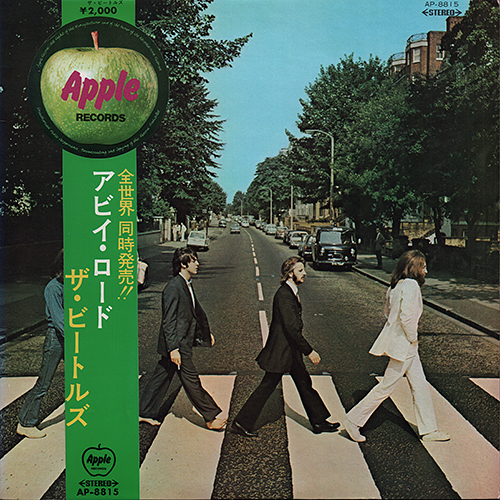 |
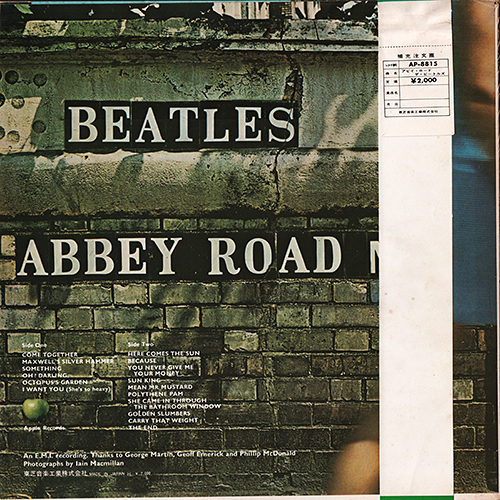 |
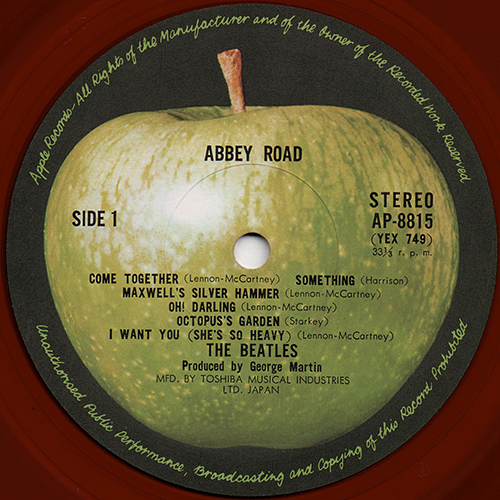 |
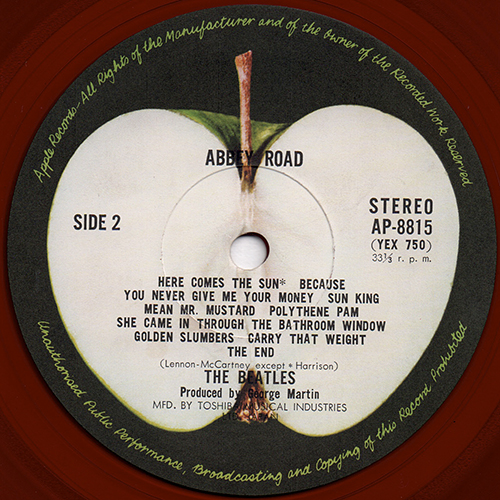 |
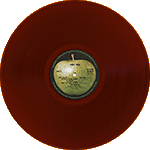 |
|
| INNER SLEEVE |
LYRIC
SHEET (Slip Sheet Type) Type-2 |
||||
| FRONT --> Click! | BACK --> Click! | FRONT --> Click! | BACK --> Click |
With
Apple
custom black inner sleeve. The lyric sheet is slip sheet type. |
|
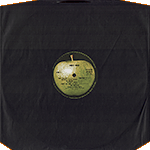 |
 |
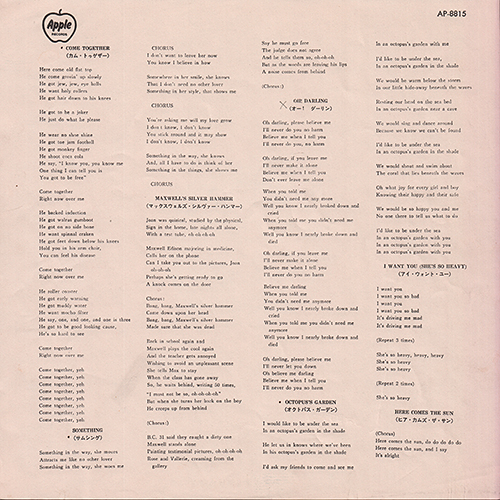 |
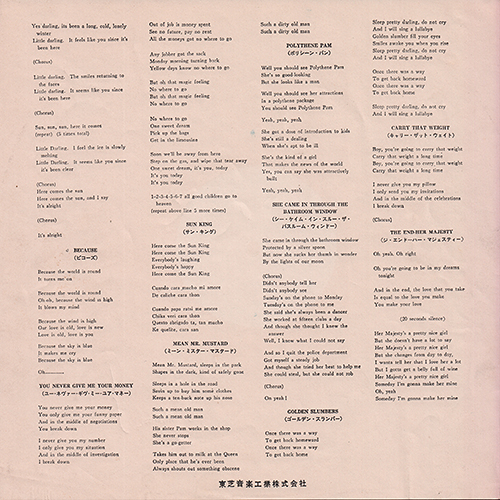 |
||
| LYRIC
SHEET TYPE-2 CLOSE UP |
|||||
 |
 |
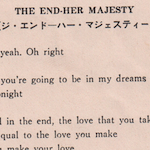 |
With "Her Majesty" lyric. | ||
| Catalog
number
and
the company name "Toshiba Musical Industries Ltd." were
printed on the lyric sheet. |
|||||
| Apple "Gourd" in dark green OBI CLOSE UP | |||||
| FRONT --> Click! | BACK --> Click! | ||||
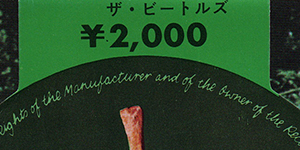 |
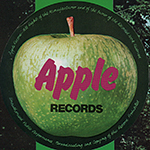 |
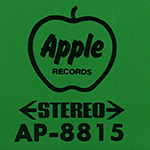 |
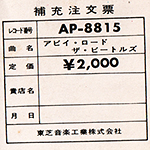 |
||
| Issued with a narrow Obi with a large
round Apple logo at the top, has a dark green
background. The word "STEREO" and Apple logo mark and
catalog number "AP-8815" were printed on the front. 1st.
pressing had a priced ¥2,000 on rear sleeve and obi strip. |
The obi remains intactwith the order form on the back uncut. | ||||
| FRONT COVER CLOSE UP | FRONT COVER CLOSE UP | ||||
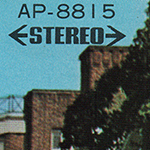 |
Catalogue number "AP-8815"
and "the word "STEREO" were printed at the upper right
corner of the front cover. |
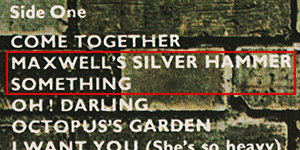 |
The song order on the back
cover is incorrect. "Maxwell's...." and "Something" should be interchanged. |
||
|
BACK
COVER CLOSE UP
|
|||||
 |
"Toshiba
Musical Industries Ltd." and "H-¥2,000" was printed at the
bottom of the back cover. |
||||
| LABEL CLOSE UP | |||||
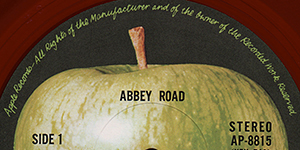 |
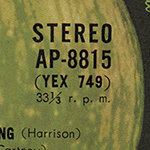
|
Toshiba pressed a
lot of their records on red, "Everclean" vinyl from 1958
through 1974 (maybe). The Everclean vinyl was designed
to be less prone to collecting static electricity and dust
than the more common black vinyl. In 1969, Toshiba had to reissue on the Apple label all the records previously issued on the Odeon label.The phrase "Apple Records - All Rights of the Manufacturer and of the Owner of the Recorded work Reserved." was printed at the perimeter. |
|||
| LABEL CLOSE UP | |||||
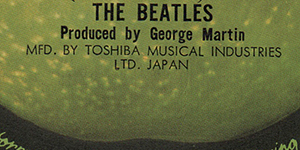 |
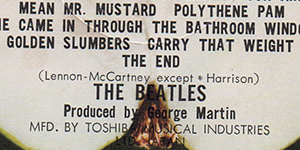 |
The label does not have "Her Majesty"
credit on the side 2. The words "MFD. BY TOSHIBA MUSICAL INDUSTRIES LTD. JAPAN" was printed at the bottom of the label. |
|||
|
OTHER ITEM
|
|||||
| - | |||||
| RECORD LABEL | Dark Green Apple label Type-1 |
||||
| MIX | STEREO |
||||
| MATRIX No. | SIDE 1 | YEX-749 1S 2 |
|||
| SIDE 2 | YEX-750
1S 10 |
||||
| PRESS MARK | 9K |
||||
| VINYL COLOR | RED |
||||
| RECORD COMPANY'S NAME | SLEEVE | Toshiba
Ongaku kogyo Kabusikigaisha |
|||
| LABEL | MFD. BY
TOSHIBA MUSICAL INDUSTRIES LTD. JAPAN |
||||
| SYMBOL/PRICE | H - ¥2,000 |
||||
| LYRIC SHEET STYLE | Slip Sheet Type-2: With "Her Majesty" lyric version | ||||
| COVER FORM | Single type. Hard cover. |
||||
| INNER SLEEVE |
Apple custom black sleeve |
||||
| OBI |
Apple "Gourd" in dark green Obi |
||||
| COVER DESIGN/ PHOTO/ NOTES | Photo: Iain Macmillan |
||||
|
COMMENTS
|
Dark green Apple label
Type-1with black print. The song order on the back cover is incorrect. "Maxwell's...." and "Something" should be interchanged. The label does not have "Her Majesty" credit on the side 2. The words "MFD. BY TOSHIBA MUSICAL INDUSTRIES LTD. JAPAN" was printed at the bottom on the label. In Novemver 1968, that was the date when Apple Corp Ltd. of England and Toshiba came to an agreement on the manufacturing and distribution of the Beatles' records in Japan. As part of that agreement, Toshiba had to reissue on the Apple label all the records previously issued on the Odeon label. The sleeves also had to be altered to desplay the Apple logo. Futher still, all the Odeon catalog number prefixes were changed to ones with Apple prefixes. In most cases, only the prefixes were changed and the catalog numbers were left intanct. Odeon singles, EPs, and LPs with the OR or OP prefixes were changed to Apple singles, EPs, and LPs with the AR or AP prefixes, respectively. But Toshiba did not instantly implement all these changes and did not immediately withdraw all Odeon label records. In fact, the phasing out of the Odeon label products and the phasing in of the Apple label was a lengthy process taking several months at least. The very first record in Japan issued under the Toshiba/Apple contract and bearing the Apple label was "The Beatles double LP (the White Album)", released on 21th. January 1969. And unlike elsewhere in the world, the first single in Japan to bear the Apple label was not "Hey Jude / Revolution" but rather "Ob- La-Di, Ob-La-Da / While My Guitar Gently Weeps", released on 10th. March, 1969. Red vinyl: Besides good sound and quality printing, Japanese records also offered some other things of interest to the collector. One of the primary manufacturing companies in Japan, Toshiba, pressed a lot of their records on red, “Everclean” vinyl from 1958 through 1974 (maybe). While not pressed as collectors’ items, these red vinyl pressings are more sought out by collectors than their black vinyl counterparts. The Everclean vinyl was designed to be less prone to collecting static electricity and dust than the more common black vinyl. The obi: Apple "Gourd" in dark green Obi 1st. pressing issued with a narrow Obi with a large round Apple logo at the top, has a dark green background. The word "STEREO" and Apple logo mark and catalog number "AP-8815" were printed on the front. 1st. pressing had a priced ¥2,000 on rear sleeve and obi strip. While most Japanese records feature local music, a lot of music fans there like foreign music, as well. The language barrier in Japan presented a problem – should foreign album covers be changed for Japanese albums? The solution was the obi, which means “belt” or “sash”. The obi is a strip of paper, usually about two inches wide, that wraps vertically around the album cover, containing information about the artist and album in Japanese. As these strips of paper were fragile and easily torn, they are often missing, especially since consumers in the 1950s and 1960s attached little significance to them. Finding Japanese records made prior to 1970 that still have the obi intact can be quite difficult, and for some albums, nearly impossible. The inclusion of the obi can dramatically affect the price of some Japanese records, sometimes increasing the price by a factor of ten. |
||||
| TITLE | ABBEY ROAD |
||||
| CATALOG NUMBER | AP-8815 |
||||
| RELEASE DATE | 21th.
October.1969
/ First Press |
||||
| TRACK LISTING | SIDE 1 | SIDE 2 | |||
| Come Together |
Here Comes The Sun |
||||
| Something |
Because |
||||
| Maxwell's Silver Hammer |
You Never Give Me Your Money |
||||
| Oh! Daring |
Sun King |
||||
| Octopus's Garden |
Mean Mr. Mustard |
||||
| I Want You (She's So Heavy) |
Polythene Pam |
||||
| She Came In
Through The Bathroom Window |
|||||
| Golden Slumbers |
|||||
| Carry That Weight |
|||||
| The End |
|||||
| (Her Majesty) |
|||||
| FRONT --> Click! | BACK --> Click! | SIDE 1 --> Click! | SIDE 2 --> Click! | DISK | |
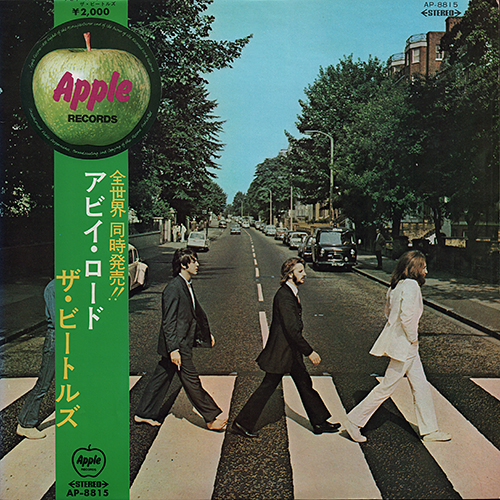 |
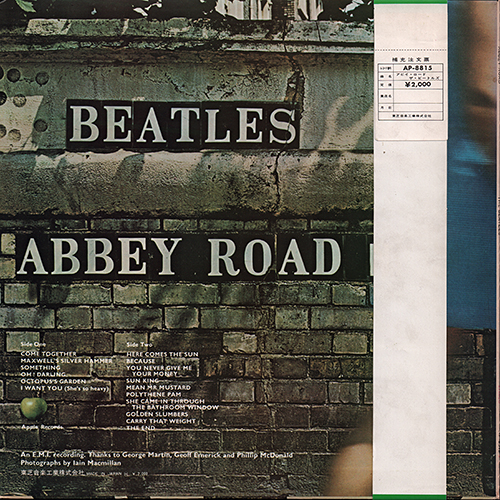 |
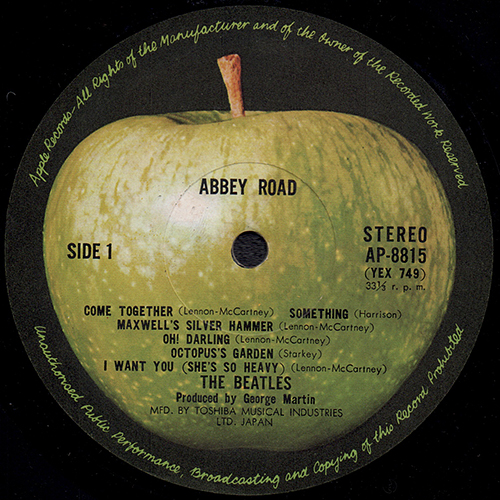 |
 |
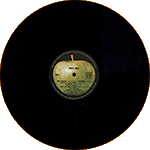 |
|
| INNER SLEEVE |
LYRIC
SHEET (Slip Sheet Type) Type-1 |
||||
| FRONT --> Click! | BACK --> Click! | FRONT --> Click! | BACK --> Click |
With
Apple
custom black inner sleeve. The lyric sheet is slip sheet type. |
|
 |
 |
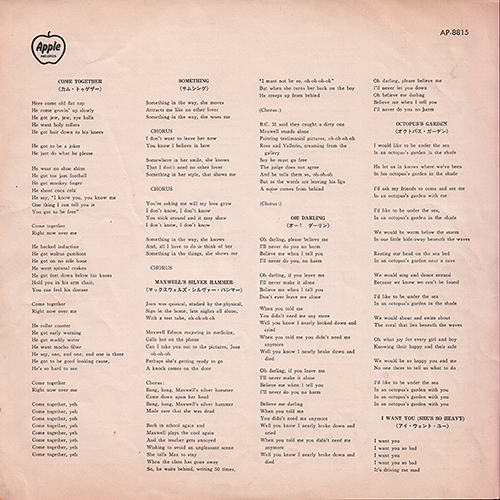 |
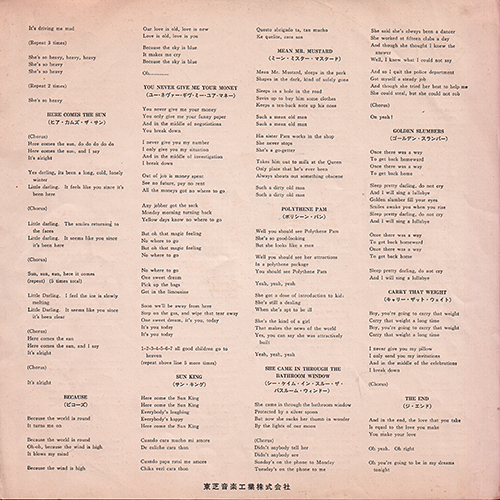 |
||
| LYRIC
SHEET TYPE-1 CLOSE UP |
|||||
 |
 |
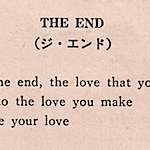 |
Without "Her Majesty" lyric. | ||
| Catalog
number
and
the company name "Toshiba Musical Industries Ltd." were
printed on the lyric sheet. |
|||||
| Apple "Gourd" in dark green OBI CLOSE UP | |||||
| FRONT --> Click! | BACK --> Click! | ||||
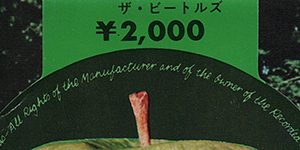 |
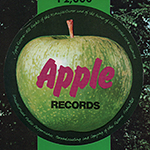
|
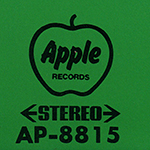 |
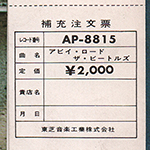 |
||
| Issued with a narrow Obi with a large
round Apple logo at the top, has a dark green
background. The word "STEREO" and Apple logo mark and
catalog number "AP-8815" were printed on the front. 1st.
pressing had a priced ¥2,000 on rear sleeve and obi strip. |
The obi remains intactwith the order form on the back uncut. | ||||
| FRONT COVER CLOSE UP | FRONT COVER CLOSE UP | ||||
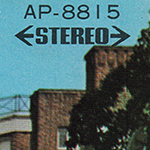 |
Catalogue number "AP-8815"
and "the word "STEREO" were printed at the upper right
corner of the front cover. |
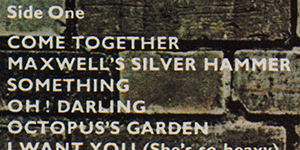 |
The song order on the back
cover is incorrect. "Maxwell's...." and "Something" should be interchanged. |
||
|
BACK
COVER CLOSE UP
|
|||||
 |
"Toshiba
Musical Industries Ltd." and "H-¥2,000" was printed at the
bottom of the back cover. |
||||
| LABEL CLOSE UP | |||||
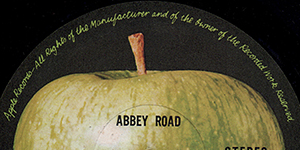 |
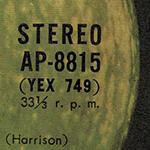 |
Toshiba pressed a
lot of their records on red, "Everclean" vinyl from 1958
through 1974 (maybe). The Everclean vinyl was designed
to be less prone to collecting static electricity and dust
than the more common black vinyl. In 1969, Toshiba had to reissue on the Apple label all the records previously issued on the Odeon label.The phrase "Apple Records - All Rights of the Manufacturer and of the Owner of the Recorded work Reserved." was printed at the perimeter. |
|||
| LABEL CLOSE UP | |||||
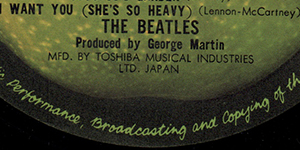 |
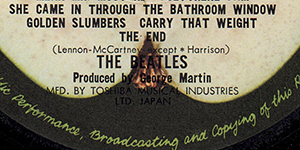 |
The label does not have "Her Majesty"
credit on the side 2. The words "MFD. BY TOSHIBA MUSICAL INDUSTRIES LTD. JAPAN" was printed at the bottom of the label. |
|||
|
OTHER ITEM
|
|||||
| - | |||||
| RECORD LABEL | Dark Green Apple label Type-1 |
||||
| MIX | STEREO |
||||
| MATRIX No. | SIDE 1 | YEX-749 1S 30 |
|||
| SIDE 2 | YEX-750
1S 29 |
||||
| PRESS MARK | 0B |
||||
| VINYL COLOR | BLACK |
||||
| RECORD COMPANY'S NAME | SLEEVE | Toshiba
Ongaku kogyo Kabusikigaisha |
|||
| LABEL | MFD. BY
TOSHIBA MUSICAL INDUSTRIES LTD. JAPAN |
||||
| SYMBOL/PRICE | H - ¥2,000 |
||||
| LYRIC SHEET STYLE | Slip Sheet Type-1: Without "Her Majesty" lyric version | ||||
| COVER FORM | Single type. Hard cover. |
||||
| INNER SLEEVE |
Apple custom black sleeve |
||||
| OBI |
Apple "Gourd" in dark green Obi |
||||
| COVER DESIGN/ PHOTO/ NOTES | Photo: Iain Macmillan |
||||
|
COMMENTS
|
Dark green Apple label
Type-1with black print. The song order on the back cover is incorrect. "Maxwell's...." and "Something" should be interchanged. The label does not have "Her Majesty" credit on the side 2. The words "MFD. BY TOSHIBA MUSICAL INDUSTRIES LTD. JAPAN" was printed at the bottom on the label. In Novemver 1968, that was the date when Apple Corp Ltd. of England and Toshiba came to an agreement on the manufacturing and distribution of the Beatles' records in Japan. As part of that agreement, Toshiba had to reissue on the Apple label all the records previously issued on the Odeon label. The sleeves also had to be altered to desplay the Apple logo. Futher still, all the Odeon catalog number prefixes were changed to ones with Apple prefixes. In most cases, only the prefixes were changed and the catalog numbers were left intanct. Odeon singles, EPs, and LPs with the OR or OP prefixes were changed to Apple singles, EPs, and LPs with the AR or AP prefixes, respectively. But Toshiba did not instantly implement all these changes and did not immediately withdraw all Odeon label records. In fact, the phasing out of the Odeon label products and the phasing in of the Apple label was a lengthy process taking several months at least. The very first record in Japan issued under the Toshiba/Apple contract and bearing the Apple label was "The Beatles double LP (the White Album)", released on 21th. January 1969. And unlike elsewhere in the world, the first single in Japan to bear the Apple label was not "Hey Jude / Revolution" but rather "Ob- La-Di, Ob-La-Da / While My Guitar Gently Weeps", released on 10th. March, 1969. Red vinyl: Besides good sound and quality printing, Japanese records also offered some other things of interest to the collector. One of the primary manufacturing companies in Japan, Toshiba, pressed a lot of their records on red, “Everclean” vinyl from 1958 through 1974 (maybe). While not pressed as collectors’ items, these red vinyl pressings are more sought out by collectors than their black vinyl counterparts. The Everclean vinyl was designed to be less prone to collecting static electricity and dust than the more common black vinyl. The obi: Apple "Gourd" in dark green Obi 1st. pressing issued with a narrow Obi with a large round Apple logo at the top, has a dark green background. The word "STEREO" and Apple logo mark and catalog number "AP-8815" were printed on the front. 1st. pressing had a priced ¥2,000 on rear sleeve and obi strip. While most Japanese records feature local music, a lot of music fans there like foreign music, as well. The language barrier in Japan presented a problem – should foreign album covers be changed for Japanese albums? The solution was the obi, which means “belt” or “sash”. The obi is a strip of paper, usually about two inches wide, that wraps vertically around the album cover, containing information about the artist and album in Japanese. As these strips of paper were fragile and easily torn, they are often missing, especially since consumers in the 1950s and 1960s attached little significance to them. Finding Japanese records made prior to 1970 that still have the obi intact can be quite difficult, and for some albums, nearly impossible. The inclusion of the obi can dramatically affect the price of some Japanese records, sometimes increasing the price by a factor of ten. |
||||
| TITLE | ABBEY ROAD |
||||
| CATALOG NUMBER | AP-8815 |
||||
| RELEASE DATE | July
1972
? / Second Press |
||||
| TRACK LISTING | SIDE 1 | SIDE 2 | |||
| Come Together |
Here Comes The Sun |
||||
| Something |
Because |
||||
| Maxwell's Silver Hammer |
You Never Give Me Your Money |
||||
| Oh! Daring |
Sun King |
||||
| Octopus's Garden |
Mean Mr. Mustard |
||||
| I Want You (She's So Heavy) |
Polythene Pam |
||||
| She Came In
Through The Bathroom Window |
|||||
| Golden Slumbers |
|||||
| Carry That Weight |
|||||
| The End |
|||||
| Her Majesty |
|||||
| FRONT --> Click! | BACK --> Click! | SIDE 1 --> Click! | SIDE 2 --> Click! | DISK | |
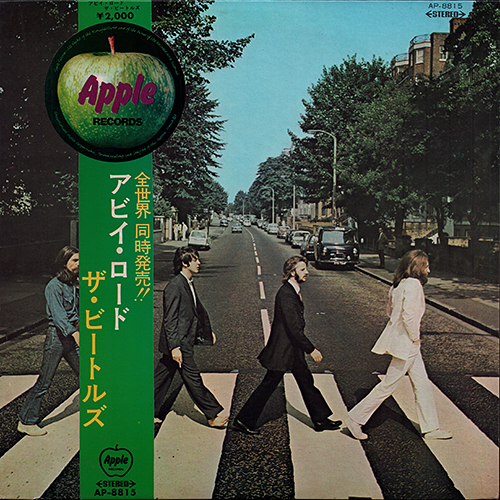 |
 |
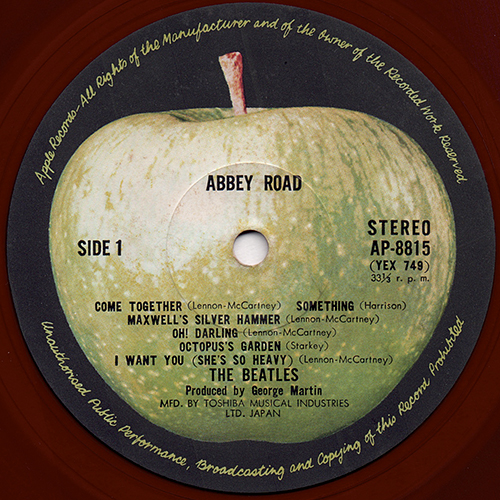 |
 |
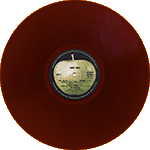 |
|
| INNER SLEEVE |
LYRIC
SHEET (Slip Sheet Type) Type-2 |
||||
| FRONT --> Click! | BACK --> Click! | FRONT --> Click! | BACK --> Click |
With
Apple custom black inner sleeve. The lyric sheet is slip sheet type. |
|
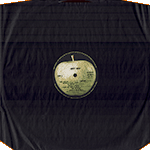 |
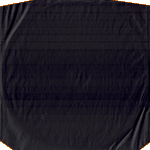 |
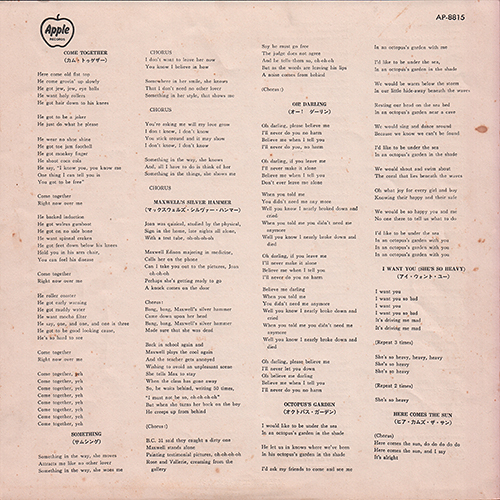 |
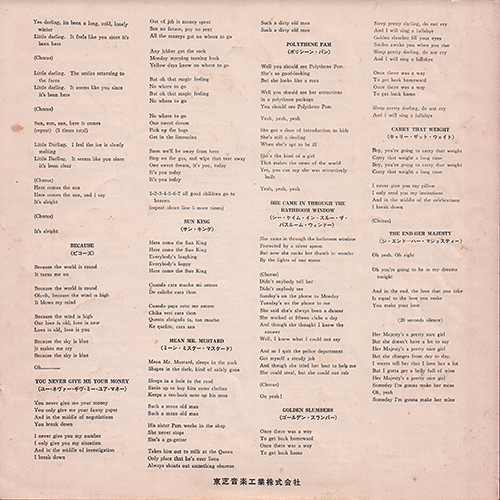 |
||
| LYRIC
SHEET TYPE-2 CLOSE UP |
|||||
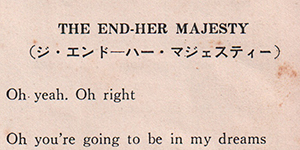 |
With "Her Majesty" lyric. |  |
|||
 |
"Toshiba Musical Industries Ltd." were printed on the lyric sheet. | ||||
| Apple "Gourd" in dark green OBI CLOSE UP | |||||
| FRONT --> Click! | BACK --> Click! | ||||
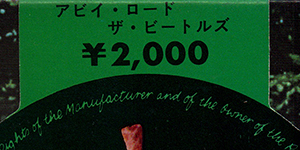 |
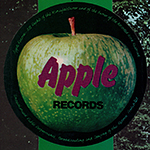
|
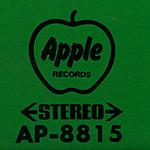 |
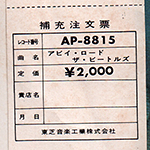 |
||
| Issued with a narrow Obi with a large
round Apple logo at the top, has a dark green
background. The word "STEREO" and Apple logo mark and
catalog number "AP-8815" were printed on the front. 1st.
pressing had a priced ¥2,000 on rear sleeve and obi strip. |
The obi remains intactwith the order form on the back uncut. | ||||
| FRONT COVER CLOSE UP | FRONT COVER CLOSE UP | ||||
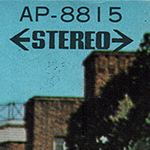 |
Catalogue number "AP-8815"
and "the word "STEREO" were printed at the upper right
corner of the front cover. |
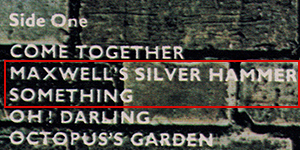 |
The song order on the back
cover is incorrect. "Maxwell's...." and "Something" should be interchanged. |
||
|
BACK
COVER CLOSE UP
|
|||||
 |
"Toshiba
Musical Industries Ltd." and "H-¥2,000" was printed at the
bottom of the back cover. |
||||
| LABEL CLOSE UP | |||||
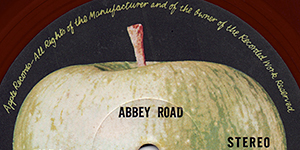 |
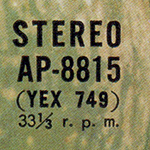 |
Light green
Apple label. In 1969, Toshiba had to reissue on the Apple label all the records previously issued on the Odeon label.The phrase "Apple Records - All Rights of the Manufacturer and of the Owner of the Recorded work Reserved." was printed at the perimeter. Toshiba pressed a lot of their records on red, "Everclean" vinyl from 1958 through 1974 (maybe). The Everclean vinyl was designed to be less prone to collecting static electricity and dust than the more common black vinyl. |
|||
| LABEL CLOSE UP | |||||
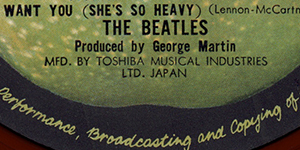 |
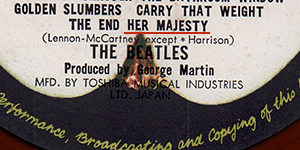 |
The label has "Her Majesty"
credit on the side 2. The words "MFD. BY TOSHIBA MUSICAL INDUSTRIES LTD. JAPAN" was printed at the bottom of the label. |
|||
|
OTHER ITEM
|
|||||
| - | |||||
| RECORD LABEL | Light Green Apple label Type-2-1 |
||||
| MIX | STEREO |
||||
| MATRIX No. | SIDE 1 | YEX-749 1S3 59 |
|||
| SIDE 2 | YEX-750
1S2 36 |
||||
| PRESS MARK | 2G |
||||
| VINYL COLOR | RED |
||||
| RECORD COMPANY'S NAME | SLEEVE | Toshiba
Ongaku kogyo Kabusikigaisha |
|||
| LABEL | MFD. BY
TOSHIBA MUSICAL INDUSTRIES LTD. JAPAN |
||||
| SYMBOL/PRICE | H - ¥2,000 |
||||
| LYRIC SHEET STYLE | Slip Sheet Type-2: With "Her Majesty" lyric
version |
||||
| COVER FORM | Single type. Hard cover. |
||||
| INNER SLEEVE |
Toshiba original plastic bag type with 5
lines in purple |
||||
| OBI |
Apple "Gourd" in dark green Obi |
||||
| COVER DESIGN/ PHOTO/ NOTES | Photo: Iain Macmillan |
||||
|
COMMENTS
|
Light green Apple
label Type-1with black print. The song order on the back cover is incorrect. "Maxwell's...." and "Something" should be interchanged. The label has "Her Majesty" credit on the side 2. The words "MFD. BY TOSHIBA MUSICAL INDUSTRIES LTD. JAPAN" was printed at the bottom on the label. In Novemver 1968, that was the date when Apple Corp Ltd. of England and Toshiba came to an agreement on the manufacturing and distribution of the Beatles' records in Japan. As part of that agreement, Toshiba had to reissue on the Apple label all the records previously issued on the Odeon label. The sleeves also had to be altered to desplay the Apple logo. Futher still, all the Odeon catalog number prefixes were changed to ones with Apple prefixes. In most cases, only the prefixes were changed and the catalog numbers were left intanct. Odeon singles, EPs, and LPs with the OR or OP prefixes were changed to Apple singles, EPs, and LPs with the AR or AP prefixes, respectively. But Toshiba did not instantly implement all these changes and did not immediately withdraw all Odeon label records. In fact, the phasing out of the Odeon label products and the phasing in of the Apple label was a lengthy process taking several months at least. The very first record in Japan issued under the Toshiba/Apple contract and bearing the Apple label was "The Beatles double LP (the White Album)", released on 21th. January 1969. And unlike elsewhere in the world, the first single in Japan to bear the Apple label was not "Hey Jude / Revolution" but rather "Ob- La-Di, Ob-La-Da / While My Guitar Gently Weeps", released on 10th. March, 1969. And in the Apple label, there are two subtypes, TOSHIBA MUSIC and TOSHIBA EMI. Further more, the early copies of the APPLE-TOSHIBA MUSIC type have dark Apple on its label, though the late copies have light one. Red vinyl: Besides good sound and quality printing, Japanese records also offered some other things of interest to the collector. One of the primary manufacturing companies in Japan, Toshiba, pressed a lot of their records on red, “Everclean” vinyl from 1958 through 1974 (maybe). While not pressed as collectors’ items, these red vinyl pressings are more sought out by collectors than their black vinyl counterparts. The Everclean vinyl was designed to be less prone to collecting static electricity and dust than the more common black vinyl. The obi: Apple "Gourd" in dark green Obi 1st. pressing issued with a narrow Obi with a large round Apple logo at the top, has a dark green background. The word "STEREO" and Apple logo mark and catalog number "AP-8815" were printed on the front. 1st. pressing had a priced ¥2,000 on rear sleeve and obi strip. While most Japanese records feature local music, a lot of music fans there like foreign music, as well. The language barrier in Japan presented a problem – should foreign album covers be changed for Japanese albums? The solution was the obi, which means “belt” or “sash”. The obi is a strip of paper, usually about two inches wide, that wraps vertically around the album cover, containing information about the artist and album in Japanese. As these strips of paper were fragile and easily torn, they are often missing, especially since consumers in the 1950s and 1960s attached little significance to them. Finding Japanese records made prior to 1970 that still have the obi intact can be quite difficult, and for some albums, nearly impossible. The inclusion of the obi can dramatically affect the price of some Japanese records, sometimes increasing the price by a factor of ten. |
||||
| TITLE | ABBEY ROAD |
||||
| CATALOG NUMBER | AP-8815 |
||||
| RELEASE DATE | December
1972
? / Second Press |
||||
| TRACK LISTING | SIDE 1 | SIDE 2 | |||
| Come Together |
Here Comes The Sun |
||||
| Something |
Because |
||||
| Maxwell's Silver Hammer |
You Never Give Me Your Money |
||||
| Oh! Daring |
Sun King |
||||
| Octopus's Garden |
Mean Mr. Mustard |
||||
| I Want You (She's So Heavy) |
Polythene Pam |
||||
| She Came In
Through The Bathroom Window |
|||||
| Golden Slumbers |
|||||
| Carry That Weight |
|||||
| The End |
|||||
| Her Majesty |
|||||
| FRONT --> Click! | BACK --> Click! | SIDE 1 --> Click! | SIDE 2 --> Click! | DISK | |
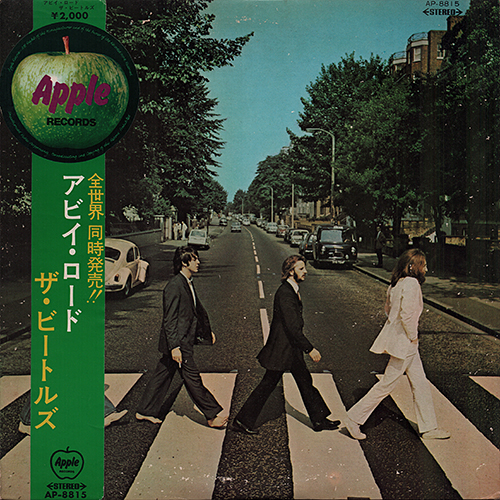 |
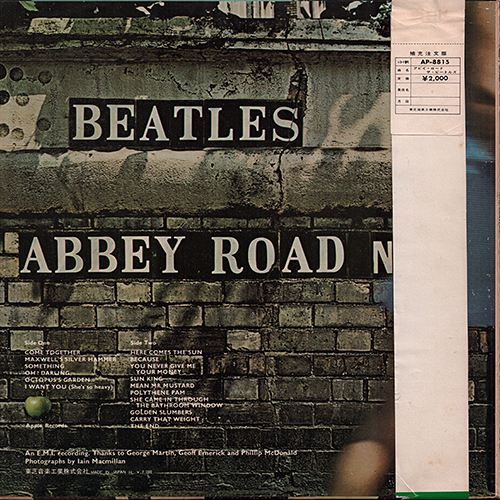 |
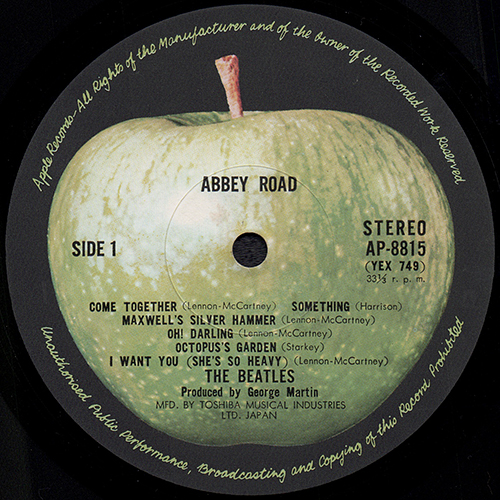 |
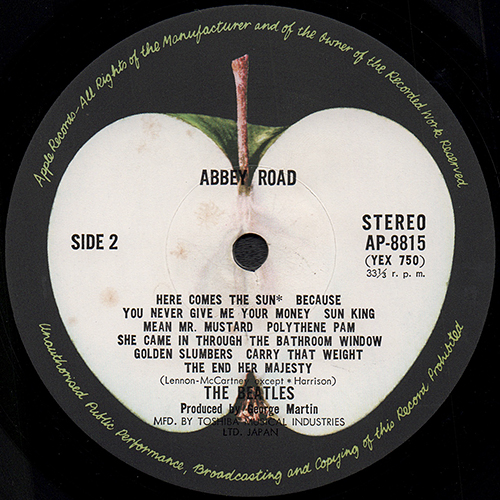 |
 |
|
| INNER SLEEVE |
LYRIC
SHEET (Slip Sheet Type) Type-2 |
||||
| FRONT --> Click! | BACK --> Click! | FRONT --> Click! | BACK --> Click |
Inner
sleeve:
Toshiba original plastic
bag type. The lyric sheet is slip sheet type. |
|
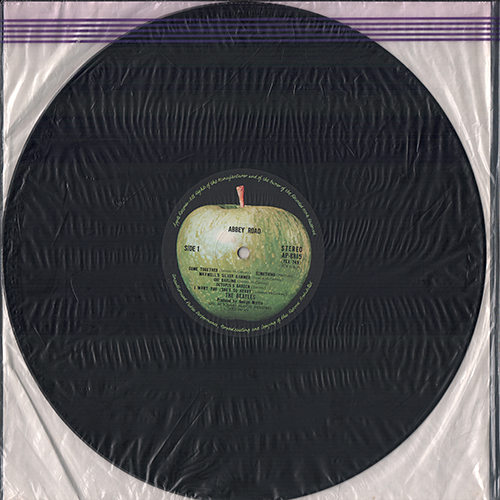 |
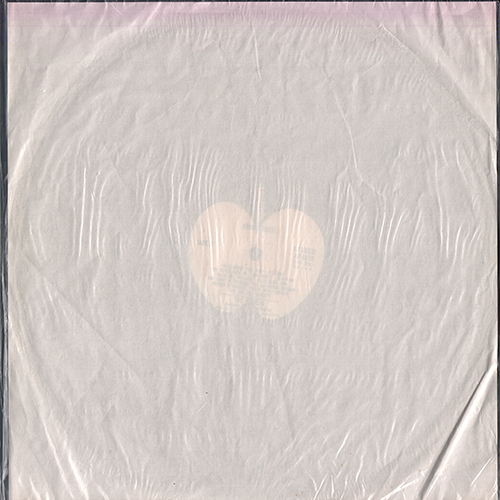 |
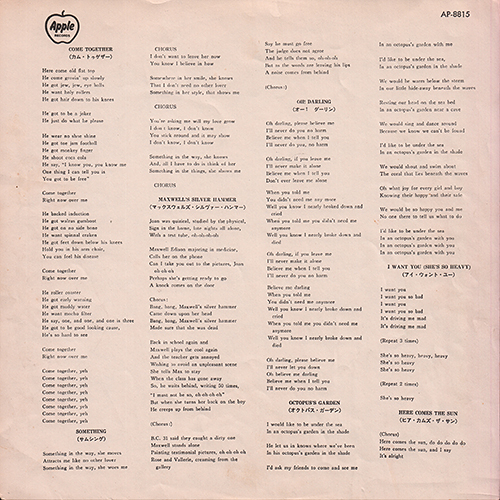 |
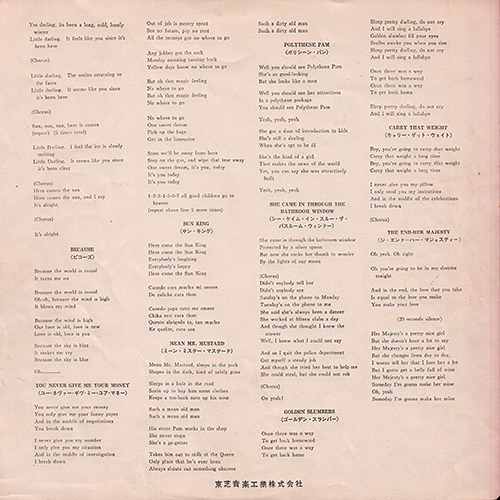 |
||
| LYRIC
SHEET TYPE-2 CLOSE UP |
|||||
 |
With "Her Majesty" lyric. |  |
 |
||
| Catalog number and the company name "Toshiba Musical Industries Ltd." were printed on the lyric sheet. | |||||
| Apple "Gourd" in dark green OBI CLOSE UP | |||||
| FRONT --> Click! | BACK --> Click! | ||||
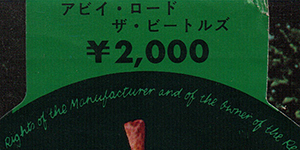 |
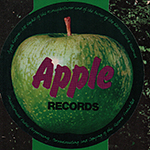
|
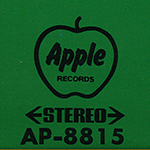 |
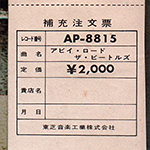 |
||
| Issued with a narrow Obi with a large
round Apple logo at the top, has a dark green
background. The word "STEREO" and Apple logo mark and
catalog number "AP-8815" were printed on the front. 1st.
pressing had a priced ¥2,000 on rear sleeve and obi strip. |
The obi remains intactwith the order form on the back uncut. | ||||
| FRONT COVER CLOSE UP | FRONT COVER CLOSE UP | ||||
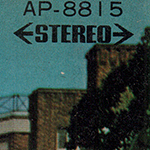 |
Catalogue number "AP-8815"
and "the word "STEREO" were printed at the upper right
corner of the front cover. |
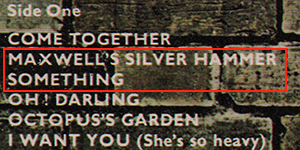 |
The song order on the back
cover is incorrect. "Maxwell's...." and "Something" should be interchanged. |
||
|
BACK
COVER CLOSE UP
|
|||||
 |
"Toshiba
Musical Industries Ltd." and "H-¥2,000" was printed at the
bottom of the back cover. |
||||
| LABEL CLOSE UP | |||||
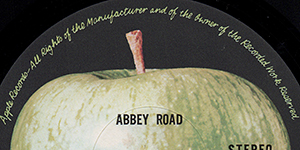 |
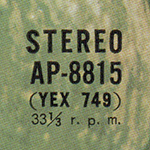 |
Light green
Apple label. In 1969, Toshiba had to reissue on the Apple label all the records previously issued on the Odeon label.The phrase "Apple Records - All Rights of the Manufacturer and of the Owner of the Recorded work Reserved." was printed at the perimeter. |
|||
| LABEL CLOSE UP | |||||
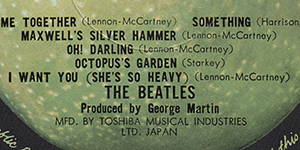 |
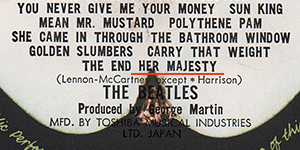 |
The label has "Her Majesty"
credit on the side 2. The words "MFD. BY TOSHIBA MUSICAL INDUSTRIES LTD. JAPAN" was printed at the bottom of the label. |
|||
|
OTHER ITEM
|
|||||
| - | |||||
| RECORD LABEL | Light Green Apple label Type-2-1 |
||||
| MIX | STEREO |
||||
| MATRIX No. | SIDE 1 | YEX-749 1S3 85 |
|||
| SIDE 2 | YEX-750
1S2 45 |
||||
| PRESS MARK | 2M |
||||
| VINYL COLOR | BLACK |
||||
| RECORD COMPANY'S NAME | SLEEVE | Toshiba
Ongaku kogyo Kabusikigaisha |
|||
| LABEL | MFD. BY
TOSHIBA MUSICAL INDUSTRIES LTD. JAPAN |
||||
| SYMBOL/PRICE | H - ¥2,000 |
||||
| LYRIC SHEET STYLE | Slip Sheet Type-2: With "Her Majesty" lyric
version |
||||
| COVER FORM | Single type. Hard cover. |
||||
| INNER SLEEVE |
Toshiba original plastic bag type with 5
lines in purple |
||||
| OBI |
Apple "Gourd" in dark green Obi |
||||
| COVER DESIGN/ PHOTO/ NOTES | Photo: Iain Macmillan |
||||
|
COMMENTS
|
Light green Apple
label Type-1with black print. The song order on the back cover is incorrect. "Maxwell's...." and "Something" should be interchanged. The label has "Her Majesty" credit on the side 2. The words "MFD. BY TOSHIBA MUSICAL INDUSTRIES LTD. JAPAN" was printed at the bottom on the label. In Novemver 1968, that was the date when Apple Corp Ltd. of England and Toshiba came to an agreement on the manufacturing and distribution of the Beatles' records in Japan. As part of that agreement, Toshiba had to reissue on the Apple label all the records previously issued on the Odeon label. The sleeves also had to be altered to desplay the Apple logo. Futher still, all the Odeon catalog number prefixes were changed to ones with Apple prefixes. In most cases, only the prefixes were changed and the catalog numbers were left intanct. Odeon singles, EPs, and LPs with the OR or OP prefixes were changed to Apple singles, EPs, and LPs with the AR or AP prefixes, respectively. But Toshiba did not instantly implement all these changes and did not immediately withdraw all Odeon label records. In fact, the phasing out of the Odeon label products and the phasing in of the Apple label was a lengthy process taking several months at least. The very first record in Japan issued under the Toshiba/Apple contract and bearing the Apple label was "The Beatles double LP (the White Album)", released on 21th. January 1969. And unlike elsewhere in the world, the first single in Japan to bear the Apple label was not "Hey Jude / Revolution" but rather "Ob- La-Di, Ob-La-Da / While My Guitar Gently Weeps", released on 10th. March, 1969. And in the Apple label, there are two subtypes, TOSHIBA MUSIC and TOSHIBA EMI. Further more, the early copies of the APPLE-TOSHIBA MUSIC type have dark Apple on its label, though the late copies have light one. Red vinyl: Besides good sound and quality printing, Japanese records also offered some other things of interest to the collector. One of the primary manufacturing companies in Japan, Toshiba, pressed a lot of their records on red, “Everclean” vinyl from 1958 through 1974 (maybe). While not pressed as collectors’ items, these red vinyl pressings are more sought out by collectors than their black vinyl counterparts. The Everclean vinyl was designed to be less prone to collecting static electricity and dust than the more common black vinyl. The obi: Apple "Gourd" in dark green Obi 1st. pressing issued with a narrow Obi with a large round Apple logo at the top, has a dark green background. The word "STEREO" and Apple logo mark and catalog number "AP-8815" were printed on the front. 1st. pressing had a priced ¥2,000 on rear sleeve and obi strip. While most Japanese records feature local music, a lot of music fans there like foreign music, as well. The language barrier in Japan presented a problem – should foreign album covers be changed for Japanese albums? The solution was the obi, which means “belt” or “sash”. The obi is a strip of paper, usually about two inches wide, that wraps vertically around the album cover, containing information about the artist and album in Japanese. As these strips of paper were fragile and easily torn, they are often missing, especially since consumers in the 1950s and 1960s attached little significance to them. Finding Japanese records made prior to 1970 that still have the obi intact can be quite difficult, and for some albums, nearly impossible. The inclusion of the obi can dramatically affect the price of some Japanese records, sometimes increasing the price by a factor of ten. |
||||
